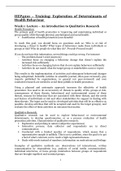HEP4210 – Training: Exploration of Determinants of
Health Behaviour
Week 1: Lecture – An introduction to Qualitative Research
Health Promotion
The primary goal of health promotion is ‘improving and maintaining individual or
group quality of life through physical, psychological and social health’.
Justification of health promotion (cost-benefit)!
To reach this goal, you should focus on questions such as: Who is at risk of
developing a threat to health? What types of behaviours make these individuals or
groups at risk? Why do people do what they do? Precede-Proceed model
If you do not have this information, several things could go wrong. For instance:
- The problem doesn’t exist (anymore)
- Activities focus on changing a behaviour change that doesn’t explain the
increased risk sufficiently
- Activities focus on changing factors that do not explain behaviour sufficiently
- Activities do not match what the target group or stakeholders want or expect
This results in the implementation of activities and subsequent behavioural changes
being suboptimal. Scientific (articles in scientific journal, often peer-reviewed), grey
(reports published by organisations, in general not peer-reviewed) and own
conducted research are needed to avoid these pitfalls in health promotion.
Using a planned and systematic approach increases the effectivity of health
promotion. You need to do an inventory of: threats to quality of life, groups at risk,
consequences of these threats, behavioural and environmental causes of these
threats, reasons for behaviour that are associated with these threats, and the needs
and desires of individuals at risk and other stakeholders for support in dealing with
these threats. The input can be used to: developed activities that will be as effective as
possible, develop activities that will be accepted and used by the target group(s), and
evaluate the effect of these activities on outcomes that matter.
Qualitative Research
Qualitative research can be used to explore behavioural or environmental
determinants, to develop questionnaires, or as a process evaluation of health
promotion activities. Characteristics of qualitative research:
Explorative and probing in nature (subjective experiences)
Interactive process; data collector and respondents are in direct
communication
Conducted with a limited number of respondents, which means that a
representative sample is unlikely. This is not a problem, since the goal is to get
a feel of what’s relevant, not to reach a high representativeness.
Deals with words instead of numbers; information on motivations and feelings
Examples of qualitative methods are: observations (of interactions), written
communication by respondents (e.g. analysis of social media communication),
individual interviews, or focus groups (interaction between groups of respondents
that are brought together) and nominal groups.
1
, The process of qualitative data collection
- Thematize; identify the goal(s) of your study, check whether the information
you need is not found elsewhere (scientific and grey literature, scientific
network), writing a problem statement can help clarify what information needs
to be collected and why.
- Design your study and develop questions; select a type of qualitative method
based on your needs (individuals vs. group, observation vs. interaction, extent
of interaction with data collector) and think about how many respondents
need to be involved (identification of subgroups? Recruitment and data
collection plan).
- Conduct and record the interviews; data is usually recorded (audio only or
video) to facilitate content analysis, or to have an objective record. Important
interview skills are to ask open questions, to affirm (show empathy,
understanding and respect, don’t judge), reflect, and summarize.
o Inductive vs. deductive data collection.
- Transcribe the recordings to written text; what was said and how it was said.
This is very time consuming.
- Analyse the data; read the transcripts several times to familiarize with the
collected data, identify recurring topics/themes, and develop a coding tree. A
coding tree is a structure that simplifies the data collected. It can be collected
before data collection (deductive, based on theory) or during the process of
familiarization (inductive).
- Verify the data; during data collection (triangulation, ask about topics in more
than one manner), during analysis (assess whether (sub)topics occur in several
interviews), and/or after analysis (perform a member check). It’s never going
to be objective, but it doesn’t have to be since you’re exploring the subject.
- Report your findings (in articles/reports).
Inductive data collection: use data to identify important
topics and translate those to theoretical constructs, possibly
even theory development. This is a bottom-up approach. It’s
more often used when not much information is available
about the behaviour yet. The questioning is more open and
explorative.
Deductive data collection: using existing theory as a basis
and matching patterns in the data with theoretical
constructs. This is a top-down approach. It might be used if there is already more
known about the behaviour under study. The questioning is more directive.
Week 1: Online Lecture 1A – Focus your research
For your research, you identify a general study aim; determinants of a specific
behaviour in a specific group. Then you check current evidence Has your study
already been done? Does is answer your questions? Is the study quality sufficient?
Sources of current evidence: basic literature (books/book chapters), scientific
literature, grey literature, experts/(research) databases. When you’re not satisfied
with the answers you get from current evidence, you conduct your own research.
Formulation a problem statement:
A logical summary of the information you have identified & how it relates to
each other
Funnel shaped: health problem behaviour & target group determinants
2




